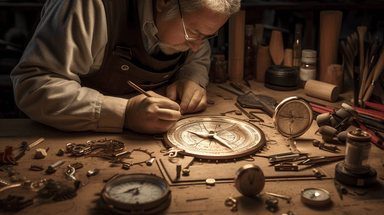31st Aug 2023
The Science of Navigation: How the Brass Pocket Compass Works
Brief History of Navigation
Navigating the vast expanse of our planet's waters is a skill that's as ancient as human exploration itself. From the indigenous peoples of Australia paddling canoes across oceanic channels, to the great European navigators who discovered new lands, the concept of finding one's way on Earth has always been integral to our story as a species. In the earlier days, sailors relied on the stars, sun, and even the colour of the ocean to guide them, but the invention of navigational tools marked a revolutionary shift in how we explored the world.
Importance of the Compass in Maritime History
Enter the compass—a tool so essential that its absence is nearly inconceivable in any discussion about navigation. This seemingly simple device fundamentally changed maritime history by offering a reliable means to determine direction, irrespective of weather or visibility. Its invention led to more daring voyages, mapping of sea routes, and the connecting of worlds previously unknown to each other. In short, the compass made the world a lot smaller and far less mysterious.
Introducing the Focal Point: The Brass Pocket Compass
While technology has brought forth advanced GPS and electronic navigational aids, the humble compass still holds its own, especially in the form of beautiful, artisan-crafted brass pocket versions. Compact, functional, and aesthetically pleasing, the brass pocket compass is both a tool and a treasure, a nod to maritime history and a handy gadget for modern-day explorers.
The Quintessential Piece of Maritime History
The Compass as an Indispensable Tool
In maritime terms, the compass is the proverbial bread and butter of navigation. It is impossible to discuss the adventures of Captain James Cook or the explorations along the Australian coast without acknowledging the role of this quintessential instrument. Its resilience in the face of technological advancement is testament to its indispensability.
Its Role in Australian Maritime History
Australia, a continent defined by its expansive coastlines and maritime exploits, has a unique relationship with the compass. From the early days of settlement, where understanding wind patterns and ocean currents were essential for survival, the compass proved invaluable. It has played a part in everything from military strategies in the Pacific to helping indigenous fishers navigate the Torres Strait. It is a tool that transcends time, culture, and technological advancements.
Basic Principles of a Compass
How a Compass Works: Simplified
The compass is genius in its simplicity. At its heart is a magnetised needle that is free to rotate and align itself with Earth's magnetic field. When you hold a compass level, the needle will point toward the magnetic North Pole, providing a stable reference point for determining other directions. Even in its simplest form, a compass can be a lifesaver.
The Importance of Magnetic Fields
Earth's magnetic field is a natural phenomenon that not only makes compass navigation possible but also protects our planet from harmful solar radiation. This invisible force field is like the Earth's fingerprint, unique and ever-changing. Compasses tune into this magnetic field, serving as a conduit between our planet's natural properties and our need to explore it.
The compass, particularly in its compact, brass pocket form, remains a timeless reminder of humanity’s instinctual need to explore, understand, and connect. It serves as a bridge between our past, when the world was a vast, uncharted expanse, and our present, where even in the face of high-tech options, simplicity often reigns supreme.
Stay tuned as we delve further into the craftsmanship and science behind these fascinating tools, which make not only for essential navigational aids but also for cherished gifts for the explorers in your life.
So, next time you find yourself facing the great blue yonder, remember that with a good compass, you're never truly lost—just on a different kind of adventure.
The Craftsmanship Behind Brass Pocket Compasses
Materials and Design
When it comes to crafting a brass pocket compass, the devil is in the details. The casing is usually made from high-quality brass, lending both durability and a touch of old-world elegance to the piece. Brass is not only corrosion-resistant but also develops a beautiful patina over time, giving each compass its own unique character. The glass cover is typically made of scratch-resistant material to ensure clarity over long periods of use.
Artisanal Touches That Make Each Compass Unique
What sets a brass pocket compass apart from its mass-produced counterparts are the artisanal touches. These may include intricate engravings on the casing, custom-designed compass roses, and the calibration that comes from skilled hands. Such nuances serve not only an aesthetic function but also attest to the quality and care that goes into creating each piece. These compasses make excellent gifts, and you can even find specially designed ones for family members like yourdaughter,son,husband, ordad.
The Heart of the Compass: The Magnetised Needle
Composition of the Needle
The needle is, without a doubt, the soul of the compass. Typically made from a lightweight metal like aluminium, the needle is magnetised to interact with Earth’s magnetic field. The process of magnetising the needle is crucial; it needs to be done in such a way that the magnetisation lasts, ensuring the compass remains functional over time.
How It Aligns Itself
The beauty of a compass lies in its simplicity. The magnetised needle is balanced on a low-friction pivot point, allowing it to move freely. When held level, the needle aligns itself with the Earth's magnetic field, pointing towards the magnetic North. The accuracy of this alignment is testament to the craftsmanship that goes into balancing and calibrating the needle.
The Compass Rose: More Than Just a Pretty Face
Importance of the Compass Rose
The compass rose is not just a decorative feature; it's an essential aspect of navigation. Traditionally imprinted on the face of the compass beneath the glass cover, it shows cardinal directions like North, South, East, and West, as well as intermediary directions like Northeast and Southwest.
Its Role in Navigation
The compass rose aids in translating the needle's direction into navigable headings. By understanding where the needle points in relation to the compass rose, one can determine their orientation in the real world with great accuracy. Whether you're out at sea or trekking through a forest, the compass rose serves as your silent guide, transforming the simple pointing of a needle into actionable intelligence for your journey.
Craftsmanship and science come together beautifully in the brass pocket compass, offering not only a utilitarian tool but also a piece of art steeped in history and cultural significance. It’s a pocket-sized treasure that continues to play an important role in our explorations and adventures, from the vast oceans to the intricate pathways of our everyday lives.
How to Read a Compass: A Quick Guide
Basic Steps for Reading a Compass
Reading a compass may seem like an ancient art form, but in reality, it's fairly straightforward. Here are the basic steps:
- Hold the Compass Level: Make sure the compass is flat so the needle can move freely.
- Identify the Magnetic Needle: This is usually the red-tipped needle that moves freely.
- Turn the Compass: Rotate your compass until the "N" on the compass rose aligns with the magnetic needle pointing North.
- Read the Heading: The number at the index line is your heading, given in degrees from North (0-360°).
By following these steps, you can determine your direction relative to magnetic North.
Tips for Precise Navigation
While the basics are simple, there are tips for more accurate navigation:
- Check for Interference: Keep the compass away from metallic and electronic objects that could disrupt the magnetic field.
- Calibrate: Some high-quality compasses allow for magnetic declination adjustments; make use of this if possible.
- Verify: Use landmarks and maps to confirm your direction, cross-referencing your compass reading.
A Compass is Not Just a Tool, It's a Gift
The Perfect Gift for Your Son (Brass Pocket Compass for Son)
A brass pocket compass is more than just a navigation tool; it's a token of trust and independence. It says, "I trust you to find your own way," making it the perfect gift for your son as he ventures into the world.

A Memorable Gift for Husbands (Brass Pocket Compass for Husband)
For husbands who love the great outdoors or have a penchant for adventure, this isn't just a compass—it's an invitation to explore, together or individually. The high-quality craftsmanship also makes it a sentimental keepsake.

An Ideal Gift for Fathers (Brass Pocket Compass for Dad)
For the father who has been the family's guiding force, a brass pocket compass is a poignant way to say, "You've guided me; now this can guide you."

Debunking Myths: Demystifying Common Misconceptions
Common Myths About Compasses
- "Compasses Always Point True North": In reality, they point to magnetic North, which can differ from true North.
- "Compasses Are Unreliable in Cold Weather": High-quality compasses function well in various conditions, including cold weather.
- "Digital Compasses Are More Accurate": This isn't necessarily true; it depends on the calibration and interference.
What's True and What's Not
While some may argue that compasses are outdated in the era of GPS technology, the truth is they offer a reliable, non-electronic means of navigation that has stood the test of time. The myths often arise from misunderstandings or misuse, but a well-crafted compass, especially one of brass construction, remains a trustworthy tool for any adventurer.
By demystifying these misconceptions, we not only understand the tool better but also appreciate the centuries of craftsmanship and scientific advancement that have gone into making the brass pocket compass a reliable and meaningful instrument, whether you're charting a course through the wilderness or gifting it to someone special in your life.

